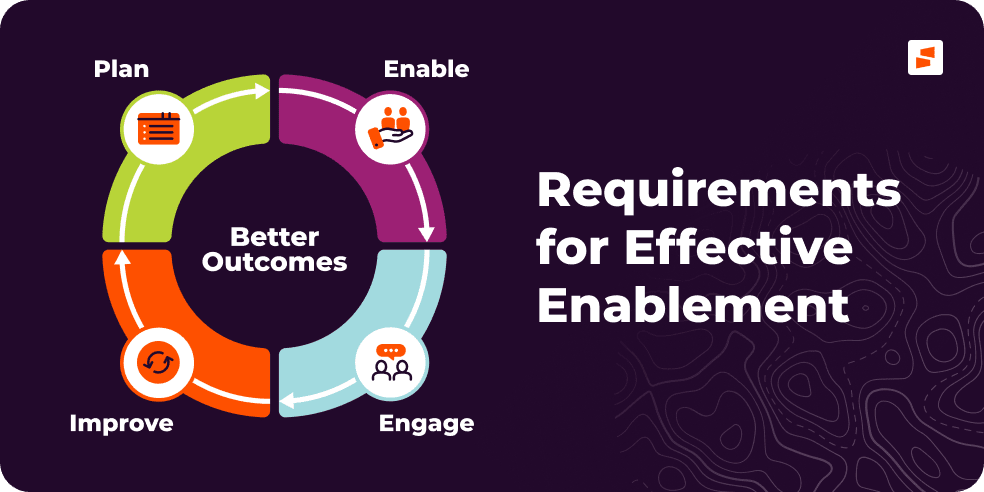What is a sales enablement plan?
Sales enablement planning identifies what go-to-market (GTM) teams need to do their jobs effectively. Essentially, it identifies the who, what, when, and why for every initiative. A sales enablement plan also creates a roadmap for the sale enablement deliverables needed to support a specific campaign so that organizations can achieve key business goals. These include:
- Tools: The solutions, platforms, and software sellers need to access and know how to use.
- Sales enablement materials: Essential enablement content includes playbooks, case studies, research reports, and pitch decks sellers will use throughout the sales process.
- Onboarding and training: New and seasoned sellers will need training so they fully understand new messaging, product features, pricing, and more.
The benefits of sales enablement
The sales process is more challenging and complex than ever before. Buyers are more informed since they can access product information, reviews, and pricing information all online. Because they’re more educated, they expect sellers to present information that is tailored to them and that will ultimately help them make a decision.
However, if sellers don’t deliver personalized information that clearly demonstrates the value of their company’s products and services, the buyer will lose interest. Therefore, sellers need a quick and effective way to learn key information, apply new knowledge, and engage with customers — which is why sales enablement is key. Sales enablement makes sure this happens by detailing processes, identifying tasks, and creating useful content that sellers need for every stage of the sales cycle.
A study from The Aberdeen Group found that companies with successful sales enablement experience 30% higher sales team quota attainment and nearly 25% higher individual seller quota attainment. However, it’s not enough to produce content, sales sheets, and training and hope for the best. Rather, you need an iterative and ongoing sales enablement strategy to ensure that your sales team is always equipped with the best resources, tools, and content. It may be time to update your sales enablement strategy if…
- Your team doesn’t follow a consistent selling process
- You can’t determine the ROI of your content
- Sellers spend too much time searching for content
- Sellers don’t know what to say or share during interactions with buyers
Did you know?
Companies with successful sales enablement experience 30% higher sales team quota attainment?
Why is sales enablement planning important?
The sales enablement planning process sets the tone and trajectory for your entire sales enablement strategy. Teams that don’t take the time to plan out efforts will struggle to effectively enable sellers and likely miss their sales enablement and performance goals. A strategic enablement framework also plays a crucial role in aligning sales teams with the company’s overall goals. Let’s take a closer look at a few of the benefits of an enablement plan.
- Identifies sales enablement content needs: The planning process is a great way for teams to define and plan the various types of content they’ll need to create or update. This can also help ensure that sellers are using the most up-to-date content so that messaging and branding is consistent across the sales org.
- Helps prioritize initiatives and resources: Sales enablement strategies are very involved and have a lot of different moving parts. Additionally, if your team has to support a number of different initiatives simultaneously, sales enablement planning helps teams prioritize initiatives and allocate resources accordingly.
- Keeps everyone organized and on-target: If you’ve ever coordinated a big project with multiple stakeholders, you know how important it is to keep tasks organized. Enablement teams also need to proactively confirm that everyone is on the same page with the goals and progress of their efforts.
- Improve sales and marketing alignment: Sales enablement also fosters greater collaboration between sales and marketing teams. It ensures that marketing’s sales enablement content strategy is designed to meet the needs of sellers. It also helps encourage sales leaders to provide feedback to marketing about what’s working in the field.
- Faster sales onboarding: With a structured sales enablement plan, new sales team members can quickly acclimate to the team and get up to speed with the knowledge and skills they need. This reduces ramp time for new hires and enables them to hit sales productivity targets and goals faster.
Planning for Enablement Success
Building a sales enablement plan
You wouldn’t set out on a trip without some type of plan in place. The same goes for implementing a new initiative at work. Let’s take a closer look at the essential steps you’ll want to take to build your organization’s own sales enablement plan.
Determine project goals
First, you need to determine what your overall sales enablement goals are. This will help you identify what sales enablement deliverables are needed. We’ve found that the best goals should directly tie the organization’s business objectives so it’s easier to determine the ROI of your initiative. It’s also important to set reasonable expectations, but add stretch goals to keep everyone motivated to drive business growth.
Identify what your team needs
Sellers benefit from your enablement plan, so it’s important to solve their most pressing pain points and challenges. Be sure to get their feedback on what they need to be more productive and successful. This will help you identify which initiatives are likely to have the biggest impact on your team. This knowledge will also help you build a sales enablement playbook, effectively provide the tools your team needs, and provide any missing training.
Define key performance indicators
After you understand the organization’s larger goals and identify seller needs, you need to determine the key metrics and outcomes you’ll use to measure the success of your sales enablement efforts. Common sales enablement KPIs include sales revenue, win rates, sales cycle length, customer satisfaction scores, and seller effectiveness.
Partner with key influencers
While enablement teams should be the main driver of the planning process, it’s still important to involve the other departments and team members. Partner with key stakeholders and influencers who you’ll need to collaborate and work with throughout the project. Remember, a sales enablement team shouldn’t own the entire initiative, instead they should lean on the expertise and skills of those across sales and marketing teams. This will help maximize the impact and overall success of your enablement initiatives.
Establish roles and responsibilities
Once you’ve identified your goals and what your team needs, it’s time to assign roles and responsibilities. There will be a number of different tasks that need to take place, and effective sales enablement planning requires delegation so everyone understands what they’re responsible for.
Set realistic timelines
Define a timeline for achieving your goals and outcomes. Consider the time it takes to implement changes, deliver training, and see the impact of the enablement efforts. Setting realistic timelines also helps manage expectations and ensures that progress is being made.
Measure and communicate success
As you execute your sales enablement plan, continuously measure and evaluate the results against your KPIs. Be sure to regularly review progress with the sales team to make data-driven adjustments to your strategy. It’s also important to communicate the outcomes and objectives with other stakeholders who were involved in the project. This ensures that everyone is on the same page and working toward the same goals.
Use the right sales enablement tool
The old way of sales planning includes project management tools, complex workflows, and context switching. This creates a slow and ineffective planning process that negatively impacts speed to market and business agility. However, a purpose-built, all-in-one sales enablement platform helps create a more streamlined sales enablement process that includes planning, sales enablement content management, training, coaching, reporting, and more. Seismic’s 2023 Value of Enablement Report found that leaders who use sales enablement software credit it for freeing up their time to focus on high-value activities. Additionally, 85% of leaders say it saves them time on enablement planning and forecasting activities.

Requirements for an effective sales enablement strategy
Remember, strategic sales enablement requires sophisticated prioritization, resource planning, and execution workflows. So, once the planning process is finished, enablement teams should move on to the other three stages of their enablement strategy. This process includes:
- Enable: After enablement teams identify what items sellers need to hit their goals, they create the appropriate sales enablement materials and deliver them to the sales team.
- Engage: Once sellers are enabled on new information, messaging, and best practices, it’s time to apply this knowledge and engage with prospects in the buying process.
- Improve: Then, enablement teams look at how sellers performed, audit content, and identify opportunities for improvement. From here, the sales enablement process starts over again so teams can iterate and improve.
Never stop growing
Power sales enablement planning with Seismic
With so many shifting priorities and last-minute changes, enablement teams don’t have the bandwidth to proactively and strategically manage enablement planning. But with the Seismic Enablement Planner™ all that changes. Now enablement teams can easily plan, execute, and iterate on all of their efforts in one place. This creates a more streamlined, strategic, and repeatable process that teams can use to connect the dots between their sales enablement strategy and sellers’ wins. Ready to learn more and put your team in the driver’s seat of your enablement planning process? Book a demo today.



